Ever flipped through a magazine and seen a very hip plant in the background? It looks a bit like a violin or a fiddle – which is where the plant gets its name.
Ficus lyrata, the fiddle leaf fig tree, is a unique plant that’s a little finicky, but well worth the effort.
How to care for Ficus lyrata? Fiddle leaf fig trees like medium to bright indirect sunlight – avoid too much direct sunlight, or you could scorch the leaves.
When watering, soak the soil but let it drain and dry out between sessions. Wipe down the leaves once a week, and prune any discoloured leaves regularly.
Fiddle leaf figs are fiddly (ha!) but make gorgeous indoor plants, so don’t let their high-maintenance reputation turn you off.
Ready to make a statement and look after some fiddle leafs? Here’s your ultimate guide to caring for fiddle leaf fig trees.
About the Fiddle Leaf Fig Tree
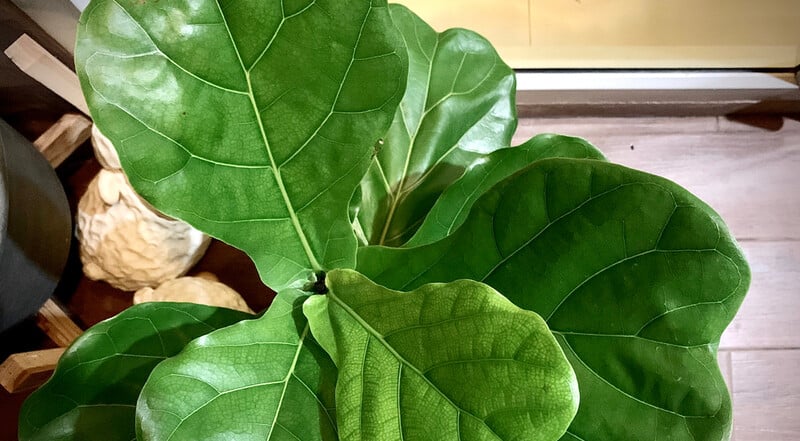
Ficus lyrata, also known as the fiddle leaf fig or the banjo fig, is a popular indoor plant. It has large, veined leaves shaped like violins.
These trees can grow over 1.80m tall (indoors, they can reach 3.0m!) and make an excellent statement plant in any room.
Fiddle leafs are broadleaf evergreen plants native to tropical Africa. They grow fast so long as they have a good environment.
The plants do have flowers, but the fiddle leaf rarely blooms outside of its native area.
Fiddle Leaf Fig Care
Ficus lyrata is known to be pretty particular about its growing conditions. We’ll give you the rundown on the best setup for your fiddle leaf plant.
But if you need more help with caring for your fiddle leaf plant, leave it in the hands of expert gardeners!
Fiddle leaf fig watering
Avoid overwatering your fiddle leaf tree – you could cause root damage. Instead, let the potting soil or the ground dry out in between your watering schedule.
If you’re growing this fig plant in a pot, ensure there are plenty of drainage holes.
Sunlight for fiddle leaf figs
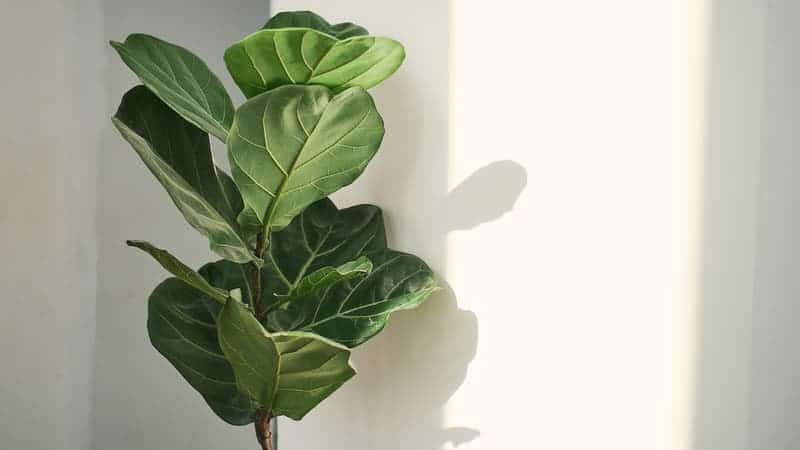
Avoid direct light exposure, especially in the afternoon. Too much light can cause damage to the leaves, while just enough light will promote healthy leaves.
Fiddle leaf plants like bright, indirect light, such as the morning sun through a window.
To improve the process of photosynthesis, wipe the leaves of your fiddle leaf fig with a soft cloth dipped in room temperature water.
Don’t use any leaf shine products – not only do those not work, but they also block the leaf pores from absorbing oxygen and sunlight.
Climate for fiddle leaf fig
Avoid severe temperature fluctuations – it’ll stress out your fig plant.
Fiddle leafs are tropical plants, so they prefer temperatures between 15º–30ºC. Avoid putting your plant out in cold air.
Since the fiddle leaf is a tropical plant, position it away from any drafts such as air conditioning or vents.
It likes humidity (between 30–60%), so you can either place a humidifier nearby, group it with other plants, or mist the plant daily.
Soil for fiddle leaf figs
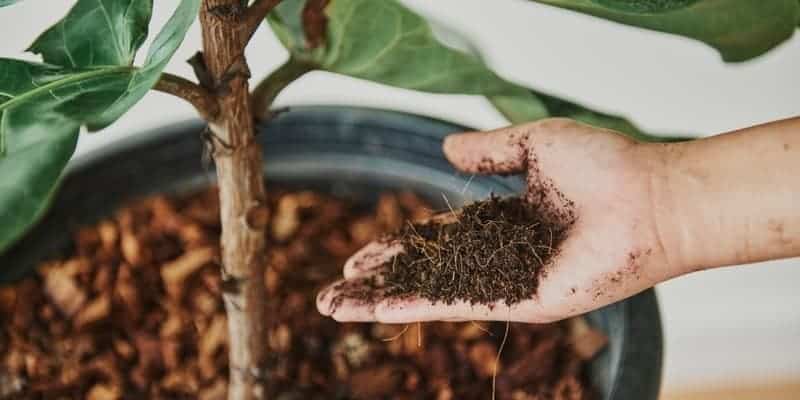
So long as the pot has fresh soil, and has a drainage hole, you’ll have an easy time keeping your plant healthy.
If you’re growing your fig plant outdoors, use soil that drains well, enriched with organic matter.
In general – choose loamy soil that drains well. If possible, go for a pH of 6–7.
We recommend Planthood’s specially-made Ficus Super Soil, perfect for fiddle leaf figs.
Fertilising a fiddle leaf fig plant
You can use nitrogen-rich indoor plant fertiliser during the growing season, or even specialised fiddle leaf plant food.
There is no need to feed a fig plant during winter.
Pruning fiddle leaf figs
Your fig plant will benefit from regular pruning, since trimming off a few leaves here and there will let the plant breathe.
Check for any overgrown or crossing branches and cut them back to about 3.0cm away from the trunk.
Meanwhile, pluck off any damaged or brown leaves.
Repotting fiddle leaf fig
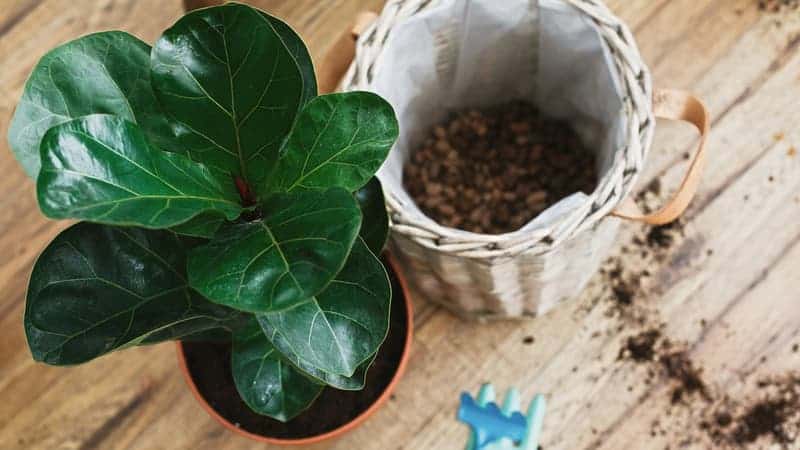
When your beloved fig plant is young, it’s essential that you repot it every year during the spring. The new container should be about 5cm larger than the previous one.
Loosen the soil around the plant and gently lift it out of its pot. Place it into the larger, new pot and backfill the potting mix.
Ensure the room isn’t too cold, or you’ll shock your plant.
Planting Fiddle Leaf Figs
If you’ve purchased a fiddle leaf starter plant from your local nursery, then planting will be very straightforward.
Choose a pot that’s 30cm wide, or dig a hole of a similar width – larger if you have a bigger plant.
Partially fill the hole with new soil or potting mix. Gently remove the plant from its container, then tease and untangle the roots. Cut away any snarls and circled roots.
Position the fiddle leaf in the hole and backfill the rest of the way. Carefully firm down the soil and water well to help the ground settle. Do not water again until the soil is dry.
How to Propagate Fiddle Leaf Fig
You can easily propagate Ficus by taking tip cuttings in spring or early summer. Take a cutting that’s 10–12cm long, with at least two large leaves.
Then you can propagate in one of two ways: in cutting mix or in water.
If you’re choosing a cutting mix (or a mix of equal parts peat and perlite), then find a pot that’s at least 10cm wide.
Fill the pot with your seeding mix. Dip the end of your cutting in rooting hormone, then stick it into the pot. Position somewhere with indirect light or partial shade.
On the other hand, you can place the cutting upright in a glass jar or bottle full of filtered water. Change the water every few days or when it becomes cloudy.
After 6–8 weeks, your cutting should start developing roots. Once a root system has started, transfer your plant into a pot with moist soil so it can continue growing.
Ficus Lyrata FAQ

Besides the right growing conditions, here are some answers to common questions about fiddle leaf care.
1. Is the fiddle leaf prone to root rot?
It is if you overwater your plant. Once you notice some leaf drop, that’s a sign that your plant may be suffering from root rot.
To avoid this, let the soil dry out between watering.
2. Do fiddle leaf figs clean the air?
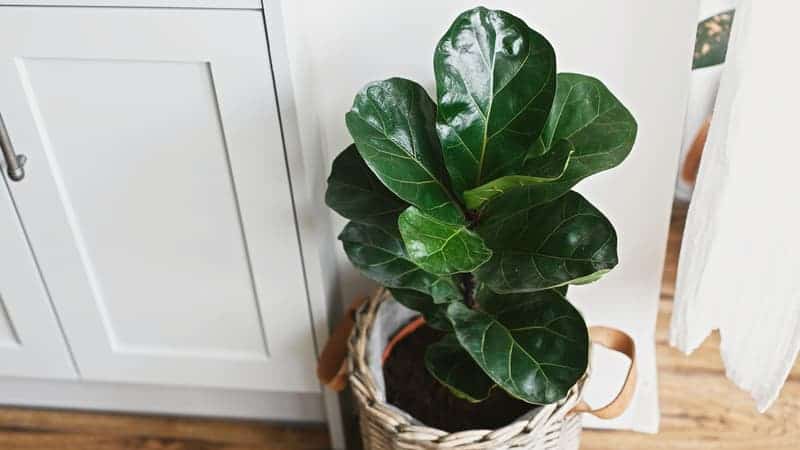
All plants clean the air around them, but fiddle leaf trees are exceptionally good at this.
They have a large leaf surface area and a high transpiration rate – meaning they release vapour into the air faster and more efficiently than most plants.
Fiddle leaf plants – alongside other leafy friends such as snake plants and peace lilies – detoxify the air around them.
This makes them excellent choices for small spaces such as offices and living rooms.
3. What are common leaf problems for fiddle leaf plants?
Checking the leaves of your fiddle leaf fig plant is a great way to track its health.
If you notice bleached areas, that means your plant is getting too much direct sun. Meanwhile, brown spots or edges are a sign of rotting roots.
If your fig plant is starting to drop leaves, it could be underwatered or overwatered. Test the soil to see if it’s soggy or if it’s starting to crumble and sink.
If it’s soggy, repot your plant ASAP and trim off any brown, mushy roots. If it’s cracking, water your plant some more.
Finally, yellowing leaves could indicate a problem with the soil. This issue can be tricky to solve since your plant may already be dying.
Trim off the affected leaves and move your plant to a pot with fresh soil.
4. Is a fiddle leaf fig safe for pets?
Nope. The leaves and stems are toxic to animals, so keep your plant out of reach of any curious critters!


